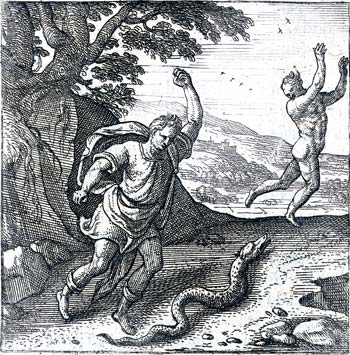In the Epiphanius version the second property of the serpent is that when it sees a clothed man it is afraid of him and flees; when it sees a naked man it attacks him. This is the opposite of what the standard Physiologus says, where the clothed man is attacked and the naked man is feared. The bestiary account also says the naked man is the one who is feared. Why the Epiphanius version reverses the two is unknown. The interpretation is also reversed: the usual meaning is that when Adam was naked in the garden the serpent could not harm him, but when he put on the "clothing" of mortality he was attacked; the Epiphanius version says that Adam was safe as long he was "clothed" with the spirit of God, but was attacked when he sinned and knew he was naked. Also, this property of the serpent is usually listed third or fourth, rather than second.
The van der Borcht copperplate engraving below follows the Epiphanius text; the naked man is fleeing from the serpent while the serpent is fleeing the clothed man.
The woodcut below (from the Rome, 1577 edition) also follows the Epiphanius text. The poses of the men in the van der Borcht illustration is an almost exact mirror image of those in the woodcut.


